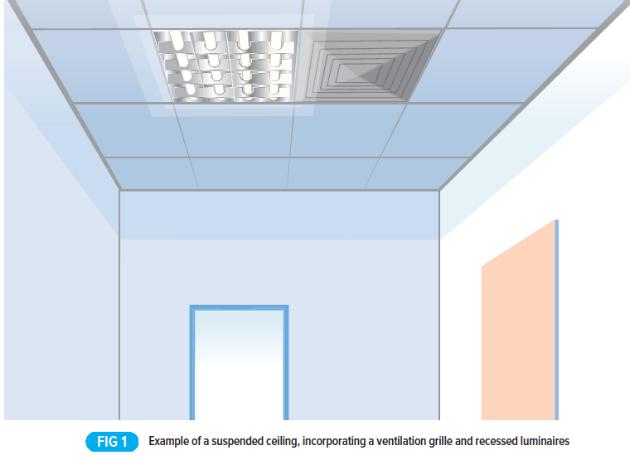This article will take a closer look at the regulations and requirements associated with installing cables in suspended ceilings.

Suspended ceilings are often provided in commercial and similar premises. They generally consist of a grid of light metal bars, usually having an inverted ‘T’ section, into which ceiling tiles, recessed luminaires (light fittings) and ventilation grilles, for example, are installed (see Fig 1).
Surface-mounted luminaires, smoke detectors and similar items are sometimes installed to the underside of the ceiling. The void above a suspended ceiling, which accommodates the tension wires or other means by which the grid is suspended from the building structure, is commonly used for the routing of wiring systems and non-electrical services, such as pipework and ductwork.
Supporting of electrical cables
Some of the requirements applicable to cables in suspended ceilings are embodied in Regulation Groups 522.6, 522.7 and 522.8 of BS 7671. In particular, Regulations 522.8.4 and 522.8.5 call for cables to be supported, either continuously or at appropriate intervals, such that no damage or undue strain will occur to the cables themselves or to their terminations.
It is inadvisable for cables, including insulated and sheathed cables to BS 6004, to be laid directly on a suspended ceiling grid for a number of reasons, including:
- The cables are liable to be damaged, both during installation and later, by the sharp edges of the grid (Regulations 522.6.201 and 522.8.1). For example, a cable may come into contact with the cut edges of the grid at a notch where sections of grid intersect, or may become trapped between a ceiling tile and the grid, possibly when other trades are carrying out work in connection with the ceiling or other services routed above.
- The suspended ceiling grid may not have been designed to take the additional weight of cables, and may deform or collapse as a result.
Adequate support for cables for fixed wiring within a suspended ceiling void can be achieved in a number of ways to ensure that the cables are kept well away from the grid and from other services. For example, the designer may consider:
- Providing a conduit or trunking system, or cable tray (metallic or non-metallic), fixed at suitable spacings to the building structure above the ceiling, or to walls or other structural elements.
- Providing a catenary system as shown in Fig 2, to which the wiring system may be attached using proprietary clips, cable-ties or cable-hangers at appropriate intervals.
- Attaching the cables by suitable clips or cable ties to ceiling support rods.
Where suspended ceilings contain wiring systems in escape routes, the cables shall be supported such that they will not be liable to premature collapse in the event of a fire (Regulation 521.11.201 refers).
Final connection to luminaires
All connections, including extra-low voltage connections, are required to be made in accordance with Regulation 526.5 of BS 7671, such as a suitable accessory or enclosure complying with the appropriate standard.
Final connection of a luminaire can be achieved by the use of a luminaire supporting coupler (LSC) mounted immediately adjacent to the luminaire (for example mounted on a conduit box above it), keeping the final flex connection as short as practicable. Alternatively, a suitable plug and socket outlet (correctly mounted) may be used. Both of these options will provide a suitable means of isolation for the connected luminaire.
An advantage of the use of LSCs or socket-outlets is that it facilitates the completion of the fixed installation without the need to have prior knowledge of the exact locations of the luminaires. Moreover, the plug-in arrangement makes the final connection and testing, and subsequent maintenance or replacement of luminaires, particularly easy and quick to carry out.
However, the ease with which final connections can be made may be an invitation to the lighting engineer to relocate the luminaires within the suspended ceiling in order to achieve a different lighting effect or intensity. From the contractor’s point of view, such changes can result in longer lengths of flexible cords, which are often left to lie on the suspended ceiling for at least part of their length.
In order to ensure compliance with Regulations 526.1, 522.6.201 and 522.8.1, the following points should all be observed:
- Flexible cord connections to luminaires should be as short as possible (ideally, a vertical drop from the fixed connection to the luminaire).
- Flexible cords should not be allowed to rest on top of, or come into contact with the sharp edges of the inverted ‘T’ section of the ceiling grid.
- Suitable cord grips should be provided to securely retain the sheath of the flexible cord if strain is likely to occur on terminations within a luminaire. For some types of luminaire, a cord grip may need to be purchased separately.
For other guidance and publications please see the ELECSA website. Information about the ELECSA Domestic Installers schemes, visit www.elecsa.co.uk
Source: https://www.voltimum.co.uk/articles/technical-guide-cables-installed




